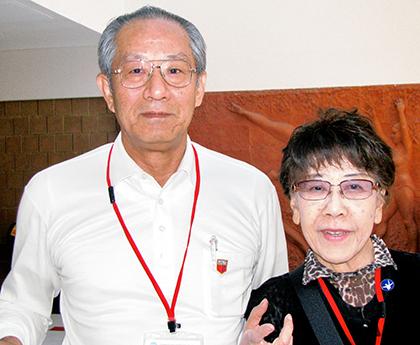By Philip Newman
In an instant, a beautiful August morning in Hiroshima was transformed into a hell of incinerated bodies and multitudes of fleeing survivors suffering from injuries of unimaginable horror. And two survivors came to LaGuardia Community College last week to tell their stories.
It was 8:16 a.m. on Aug. 6, 1945. A U.S. Army Air Corps B29 bomber dropped the world’s first atomic bomb, code-named “Little Boy.”
An estimated 70,000 people died instantly, 70,000 more died in the following three months and 240,000 people are still suffering from effects of the attack.
Much of Hiroshima, then a city of 250,000, was left a flattened, burned-out moonscape from the bomb, set to explode 1,900 feet above the city.
On Aug. 9, U.S. planes atom bombed Nagasaki, leaving more than 72,000 dead.
At Hiroshima, Yuko Nakamura, 78, and Yoshio Tamura, 77, lived though the Hiroshima attack.
Nakamura and Tamura, who visited LaGuardia in Long Island City May 5 as part of the school’s Asian Heritage Month, came on a mission to help stop the spread of nuclear weapons worldwide through the United Nations.
John Hersey wrote about that frightful day in a celebrated article — later a book — in the New Yorker magazine a year after the bombing in August 1946. The New Yorker, which published nothing but the article without cartoons or anything else in that issue, ran out of copies because the demand was so great worldwide. His article told what happened to six residents of the city.
Michele Piso of the LaGuardia faculty opened the forum by reading from “Hiroshima.”
“… Hundreds and hundreds were fleeing — and every one of them seemed to be hurt in some way. The eyebrows of some were burned off and skin hung from their faces and hands. Others, because of pain, held their arms up as if carrying something in both hands. Some were vomiting as they walked. Many were naked or in shreds of clothing. On some undressed bodies the burns made patterns — of undershirt straps and suspenders and, on the skin of some women, the shapes of flowers on their kimonos.”
Many died because they were wearing dark clothing, which conducted the heat of the nuclear blast while white garments reflected it.
“Of 150 doctors in the city, 65 were already dead and most of the rest were wounded. Of 1,780 nurses, 1,654 were dead or too badly hurt to work,” Hersey wrote.
Nakamura recalled what happened to her:
“We had heard of American bombings of not only Tokyo and Osaka but many regional cities, but Hiroshima had been spared so far although we expected to come under attack.
“One of my classmates said, ‘Look, there’s a plane. It might be a B29!’” Nakamura recalled in remarks translated by Kyoka Toyama, a LaGuardia counselor.
“A yellow-orange light flashed like a bolt of lightning. I turned my head to look in that direction when I felt a massive shock hit my body accompanied by a large boom. The blast along with broken glass and dirt blew through the inside of a factory where we were. I was knocked to the floor. A friend called to me, ‘Are you hurt?’
“My uniform was red, stained with blood from my nose and my left arm was bleeding from glass fragments. Many small glass shards were stuck into my clothes into my skin.
“I looked out and the beautiful sky of the morning had changed to black then to gray and to red then to black again. It became mushroom-shaped.
“On that day, the first-year students of my high school had been sent to work in the city center,” Nakamura said. “Those 220 girls all perished by the end of the day.”
Tamura said, “The scenes after the bombing were so gory the only word I can think of to describe it is ‘harrowing.’ Glass was broken everywhere despite that we were 4 miles from what they called ‘ground zero.’”
Nakamura and Tamura came to New York to attend the U.N. Conference on Nuclear Non-Proliferation.
“For all the rest of my life, I sincerely wish, pray and fight for all the people on Earth in this 21st century to be able to live their lives fully with dignity and peace,” Nakamura said . “No more Hiroshimas or Nagasakis.”
Reach contributing writer Philip Newman by e-mail at timesledgernews@cnglocal.com or phone at 718-260-4536.

































